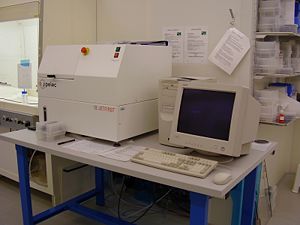Specific Process Knowledge/Thermal Process/Jipelec RTP: Difference between revisions
Appearance
mNo edit summary |
|||
| (24 intermediate revisions by 4 users not shown) | |||
| Line 1: | Line 1: | ||
{{cc-nanolab}} | |||
'''Feedback to this page''': '''[mailto:labadviser@danchip.dtu.dk?Subject=Feed%20back%20from%20page%20http://labadviser.danchip.dtu.dk/index.php/Specific_Process_Knowledge/Thermal_Process/Jipelec_RTP click here]''' | |||
'''<p style="color:red;"> The Jipelec RTP has been decomissioned in March 2023. It has been replaced with the Jipelec RTP2.</span>''' | |||
[[Category: Equipment |Thermal Jipelec]] | |||
[[Category: Thermal process|Jipelec]] | |||
==Jipelec - Rapid Thermal Processing== | ==Jipelec - Rapid Thermal Processing== | ||
[[Image:RTP_oven.jpg|300x300px|thumb|Jipelec RTP: Positioned in cleanroom | [[Image:RTP_oven.jpg|300x300px|thumb|Jipelec RTP: Positioned in cleanroom A-4/ Photo: DTU Nanolab internal]] | ||
The Jipelec is a rapid thermal processing (RTP) oven. It is be used for fast and well-controlled annealing or alloying of samples. It is possible to use either a thermocouple or a pyrometer to control the temperature (of the sample carrier). | |||
'''The user manual | '''The user manual, technical information and contact information can be found in LabManager:''' | ||
'''[http://www.labmanager.danchip.dtu.dk/function.php?module=Machine&view=view&mach=164 | '''[http://www.labmanager.danchip.dtu.dk/function.php?module=Machine&view=view&mach=164 Jipelec RTP]''' | ||
==Overview of the performance of the Jipelec RTP and some process related parameters== | ==Overview of the performance of the Jipelec RTP and some process related parameters== | ||
{| border="2" cellspacing="0" cellpadding=" | {| border="2" cellspacing="0" cellpadding="2" | ||
|- | |- | ||
!style="background:silver; color:black;" align="center"|Purpose | !style="background:silver; color:black;" align="center"|Purpose | ||
|style="background:LightGrey; color:black"| | |style="background:LightGrey; color:black"| | ||
|style="background:WhiteSmoke; color:black"| | |style="background:WhiteSmoke; color:black"|RTP annealing | ||
|- | |- | ||
!style="background:silver; color:black" align="center" valign="center" rowspan="3"|Process parameter range | !style="background:silver; color:black" align="center" valign="center" rowspan="3"|Process parameter range | ||
|style="background:LightGrey; color:black"|Process Temperature | |style="background:LightGrey; color:black"|Process Temperature | ||
|style="background:WhiteSmoke; color:black"| | |style="background:WhiteSmoke; color:black"| | ||
*0- | *0-1100 <sup>o</sup>C (only short time a the high temperatures - see the user manual) | ||
* | *III-V materials only to 450 <sup>o</sup>C | ||
*Temperature ramp up to 50 <sup>o</sup>C/min | |||
|- | |- | ||
|style="background:LightGrey; color:black"|Process pressure | |style="background:LightGrey; color:black"|Process pressure | ||
|style="background:WhiteSmoke; color:black"| | |style="background:WhiteSmoke; color:black"| | ||
*1 atm | *1 atm | ||
* | *Vacuum | ||
|- | |- | ||
|style="background:LightGrey; color:black"| | |style="background:LightGrey; color:black"|Gases on the system | ||
|style="background:WhiteSmoke; color:black"| | |style="background:WhiteSmoke; color:black"| | ||
| Line 41: | Line 49: | ||
|style="background:LightGrey; color:black"|Batch size | |style="background:LightGrey; color:black"|Batch size | ||
|style="background:WhiteSmoke; color:black"| | |style="background:WhiteSmoke; color:black"| | ||
* | *One 50 mm or 100 mm wafer | ||
*Small samples | *Small samples (placed on a carbide carrier or a Si carrier wafer with 1 µm oxide on the back) | ||
|- | |- | ||
| style="background:LightGrey; color:black"|Substrate | | style="background:LightGrey; color:black"|Substrate materials allowed | ||
|style="background:WhiteSmoke; color:black"| | |style="background:WhiteSmoke; color:black"| | ||
*Silicon | |||
*Silicon | A carrier is always needed: For III-V materials and metals a carbide carrier is used, and for other samples a silicon carrier wafer with 1 µm oxide is used | ||
*Silicon | *Silicon | ||
* | *Silicon oxide | ||
*Silicon nitride | |||
*Fused silica/quartz | |||
*Polysilicon | *Polysilicon | ||
*III-V materials (on graphite carrier, max 450 <sup>o</sup>C) | |||
*III-V materials (on graphite carrier) | *Some metals - (on graphite carrier). Ask the Thin Film group for permission | ||
* | |||
|- | |- | ||
|} | |} | ||
Latest revision as of 13:40, 4 June 2025
The content on this page, including all images and pictures, was created by DTU Nanolab staff, unless otherwise stated.
Feedback to this page: click here
The Jipelec RTP has been decomissioned in March 2023. It has been replaced with the Jipelec RTP2.
Jipelec - Rapid Thermal Processing

The Jipelec is a rapid thermal processing (RTP) oven. It is be used for fast and well-controlled annealing or alloying of samples. It is possible to use either a thermocouple or a pyrometer to control the temperature (of the sample carrier).
The user manual, technical information and contact information can be found in LabManager:
| Purpose | RTP annealing | |
|---|---|---|
| Process parameter range | Process Temperature |
|
| Process pressure |
| |
| Gases on the system |
| |
| Substrates | Batch size |
|
| Substrate materials allowed |
A carrier is always needed: For III-V materials and metals a carbide carrier is used, and for other samples a silicon carrier wafer with 1 µm oxide is used
|
